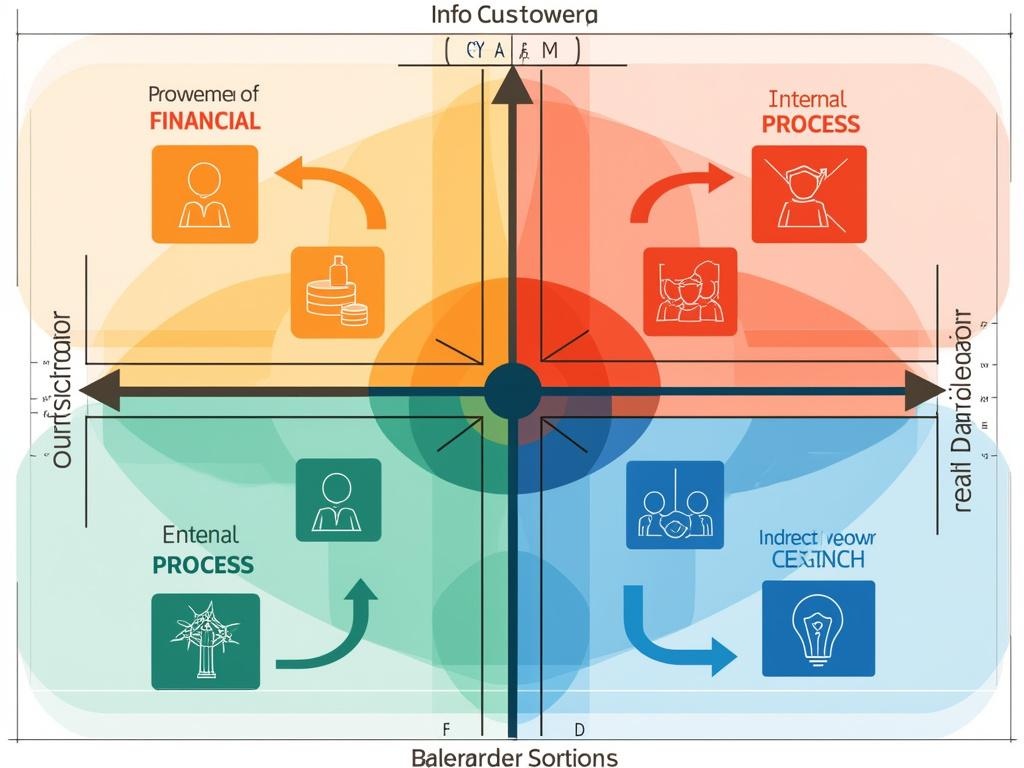
The Balanced Scorecard: A Strategic Management Framework
The balanced scorecard functions as a strategic management framework created in 1992 that expands traditional financial metrics, delivering a complete overview of organizational performance. This approach converts strategies into measurable objectives across four connected perspectives, helping organizations align their activities with strategic goals and improve performance across all areas.
Key Takeaways:
- The balanced scorecard assesses performance through financial, customer, internal process, and learning and growth perspectives.
- It provides a comprehensive approach to strategy execution that goes beyond traditional financial measurements.
- Organizations using the balanced scorecard can create better alignment between daily activities and long-term strategic objectives.
- The framework helps translate complex strategic goals into actionable, measurable initiatives.
- Successful implementation requires clear communication, executive sponsorship, and regular performance reviews.
“The balanced scorecard transforms abstract strategies into actionable objectives, offering organizations a holistic view of performance that transcends traditional financial metrics. By aligning daily activities with long-term goals across multiple perspectives, it empowers strategic execution and drives meaningful improvement.”
Origins and Definition
The balanced scorecard is a strategic management framework developed in 1992 by Robert Kaplan and David Norton at Harvard Business School. This revolutionary tool extends beyond traditional financial metrics to provide a comprehensive view of organizational performance. You’ll find the balanced scorecard is particularly valuable for translating abstract strategies into measurable objectives and actionable initiatives.
Unlike conventional performance measurement systems that focus solely on financial outcomes, the balanced scorecard is designed to create organizational alignment across all levels. This comprehensive approach ensures everyone understands how their work contributes to broader strategic goals.
Four Perspectives of Strategic Performance
The balanced scorecard is structured around four interconnected perspectives that provide a holistic view of your organization:
- Financial Perspective: Tracks economic value creation through metrics like revenue growth, profit margins, ROI, and net income.
- Customer Perspective: Measures market perception using indicators such as market share, customer retention rates, and delivery speed.
- Internal Business Process Perspective: Focuses on operational efficiency through process quality metrics, innovation rates, and regulatory compliance measures.
- Learning and Growth Perspective: Evaluates organizational capacity for improvement via employee skills assessment, training hours, and technology investments.
These perspectives work together to create a balanced scorecard to drive performance across your entire organization. By maintaining this balance, you avoid the common pitfall of overemphasizing short-term financial results at the expense of long-term value creation.
The following table illustrates how the balanced scorecard connects strategic objectives across perspectives:
| Perspective | Strategic Question | Sample Metrics |
|---|---|---|
| Financial | How do we create value for shareholders? | Revenue growth, ROI, profit margin |
| Customer | How do customers perceive us? | Satisfaction scores, retention rates, market share |
| Internal Process | What must we excel at internally? | Quality metrics, cycle time, innovation rate |
| Learning & Growth | How can we continue to improve? | Employee satisfaction, training investment, technology adoption |
When implementing the balanced scorecard, you should establish a clear strategic vision that guides the selection of appropriate metrics for each perspective. This ensures your balanced scorecard is aligned with your organization’s unique strategic priorities rather than using generic measurements.
The balanced scorecard is more than just a measurement system—it’s a comprehensive management approach that transforms how you execute strategy. By creating visibility into how different activities contribute to strategic goals, the balanced scorecard is invaluable for organizations seeking to improve performance across all dimensions.
Organizations that adopt the balanced scorecard methodology outperform their peers that do not by a significant margin in long-term performance and shareholder value.
hbr.org
Four Interconnected Perspectives of Performance
The balanced scorecard is a strategic management framework that provides a multidimensional view of organizational performance through four key perspectives. These perspectives work together to create a comprehensive approach to strategy execution and performance measurement.
Financial Perspective: Driving Economic Value
The financial perspective focuses on how your organization creates sustainable economic value and maintains financial health. This traditional aspect of performance measurement remains crucial as the balanced scorecard is designed to track your organization’s financial success through metrics like:
- Revenue growth and diversification
- Profit margins and cost structure analysis
- Return on investment (ROI)
- Cash flow management
- Net income and earnings per share
You’ll find these financial indicators serve as lagging measures that reflect the outcomes of actions already taken. They answer the critical question: “How do we look to shareholders?”
Customer Perspective: Understanding Marketplace Perception
The customer perspective examines how your organization is perceived in the marketplace and measures your success in meeting customer needs. Stakeholder satisfaction metrics in this area typically include:
- Market share percentages
- Customer retention and loyalty rates
- Customer acquisition costs
- Delivery speed and reliability
- Customer satisfaction scores
Internal Business Process Perspective: Ensuring Operational Efficiency
Your internal business process perspective evaluates operational efficiency and identifies the key processes that drive value creation. These processes must be optimized to deliver on customer expectations while meeting financial objectives. Key metrics include:
- Process quality and defect rates
- Cycle times and throughput
- Innovation rates and new product development
- Regulatory compliance adherence
- Waste reduction
Learning and Growth Perspective: Capacity for Improvement
The learning and growth perspective focuses on your organization’s capacity for improvement and value creation over time. This foundation supports all other perspectives by ensuring the right infrastructure for long-term growth. Consider tracking:
- Employee skills development
- Training hours and education investments
- Technology infrastructure capabilities
- Organizational culture metrics
- Knowledge management effectiveness
Interconnection of Perspectives
The following table illustrates how these perspectives interconnect within the balanced scorecard framework:
| Perspective | Focus Area | Sample Metrics | Strategic Question |
|---|---|---|---|
| Financial | Economic Value | ROI, Profit Margins | How do we look to shareholders? |
| Customer | Market Perception | Satisfaction, Retention | How do customers see us? |
| Internal Process | Operational Excellence | Quality, Cycle Time | What must we excel at? |
| Learning & Growth | Future Capability | Skills, Technology | Can we improve and create value? |
When implementing these perspectives, you should aim for a balanced view where each area receives appropriate attention. The balanced scorecard is not merely a collection of metrics but a cohesive framework that demonstrates how improvement in one area drives performance in others.
Expert Insight: To effectively leverage the balanced scorecard, organizations must recognize the interconnected nature of its four performance perspectives: financial, customer, internal processes, and learning and growth. Each perspective not only measures specific outcomes but also influences and enhances the others; for example, a focus on employee development can lead to improved internal processes, which in turn boosts customer satisfaction and financial results. By maintaining a balanced focus across all areas, leaders can ensure their organization is not only achieving immediate goals but also building a sustainable foundation for future success.
Implementation Framework
Implementing a balanced scorecard is a structured process requiring careful planning and execution. The balanced scorecard is a strategic management system that helps organizations translate their vision into actionable objectives across multiple dimensions.
Core Implementation Components
To successfully implement a balanced scorecard, you’ll need to focus on these essential components:
- Strategy Map: Create a visual representation connecting your strategic objectives across the four perspectives. This map shows how improvements in learning and growth drive better internal processes, which enhance customer value and ultimately improve financial outcomes.
- Key Performance Indicators (KPIs): Develop quantifiable metrics for each objective. Your KPIs should be SMART (Specific, Measurable, Achievable, Relevant, Time-bound) to effectively track progress against strategic goals.
- Targets and Thresholds: Establish clear performance targets with minimum, expected, and stretch goals for each KPI.
- Strategic Initiatives: Define specific projects and actions required to achieve your objectives.
- Reporting Dashboard: Create a visual dashboard to monitor performance regularly.
The balanced scorecard is most effective when you develop strategic planning processes that clearly connect day-to-day activities with long-term vision.
Successful implementation depends on several critical factors:
- Executive sponsorship and active leadership involvement
- Clear communication of strategic objectives to all stakeholders
- Cross-functional team participation to ensure diverse perspectives
- Regular performance reviews and scorecard updates
- Integration with existing management systems
- Technology support for data collection and reporting
- Stakeholder satisfaction through meaningful engagement
When implementing the balanced scorecard, you’ll face common challenges such as resistance to change, difficulty establishing relevant metrics, and maintaining momentum beyond initial launch. You can overcome these by providing adequate training, starting with a pilot program, and demonstrating early wins.
The balanced scorecard is particularly valuable for helping executives balance competing priorities across different business aspects. By connecting financial measures with operational, customer, and development indicators, you gain a comprehensive view of organizational health and progress toward strategic goals.
Remember that the balanced scorecard is not just a measurement system—it’s a management framework that enables strategic alignment throughout your organization. When properly implemented, it transforms abstract strategies into concrete actions that drive performance improvement and sustainable growth.

Real-World Application and Case Studies
The balanced scorecard is a transformative management tool that organizations worldwide have successfully implemented. By 2004, approximately 57% of global companies had adopted this framework, demonstrating its widespread acceptance as a strategic alignment methodology.
When you implement a balanced scorecard approach, you can achieve remarkable results similar to these noteworthy case studies:
- Mobil USM&R transformed from an industry laggard to leader by using the balanced scorecard to align their strategic objectives. Their comprehensive implementation helped them improve financial performance dramatically, moving from last to first place in profitability among industry peers.
- The Ethiopian Ministry of Health leveraged the balanced scorecard to enhance healthcare delivery and outcomes across their national system. Their approach focused on balancing financial constraints with quality improvements in service delivery.
- Infosys utilized the balanced scorecard for aligning their IT infrastructure with business objectives, resulting in better resource allocation and improved project delivery timelines.
Key Benefits Observed Across Organizations
Organizations implementing the balanced scorecard consistently report several tangible benefits:
- Improved strategy execution through clearer alignment of daily activities with strategic goals
- Enhanced cross-departmental communication by creating a shared language around strategic priorities
- Better financial performance resulting from more balanced focus across all operational aspects
- Increased accountability through measurable metrics tied to strategic objectives
- More effective resource allocation based on strategic priorities
The success of these implementations hinges on several critical factors. You’ll need to ensure effective communication across project teams and maintain strong leadership support throughout the implementation process. Additionally, ongoing performance management is essential to sustain momentum and drive continuous improvement.
Organizations that have succeeded with the balanced scorecard typically follow a structured approach to implementation. This includes developing a clear strategy map, selecting appropriate KPIs, and creating action plans tied to strategic objectives. By following these steps, you can create a strategic dashboard that drives organizational alignment and performance improvement.
The balanced scorecard is particularly effective because it provides a framework for translating abstract strategic concepts into concrete, measurable actions. This translation process helps bridge the gap between strategic planning and operational execution, ensuring your organization’s daily activities contribute meaningfully to long-term objectives.
Organizations that embrace the balanced scorecard framework are 1.5 times more likely to achieve their strategic objectives than those that do not.
hbr.org
Comparative Advantages
The balanced scorecard is a strategic management system that offers several distinct advantages over traditional performance measurement approaches. When properly implemented, this framework transforms how you track and achieve strategic objectives by providing a comprehensive view of organizational health.
Key Differentiators
The balanced scorecard is more than just a measurement tool—it’s a complete management system that helps you connect strategy with execution. Here’s what sets it apart:
- Holistic Performance View: Unlike financial-only approaches, the balanced scorecard is a multi-dimensional framework incorporating financial metrics alongside customer satisfaction, internal processes, and learning capabilities. This comprehensive approach ensures you don’t sacrifice long-term value for short-term gains.
- Strategic Alignment: The balanced scorecard is especially powerful for creating alignment across your organization. It translates high-level strategy into specific objectives at every level, ensuring all departments work toward common goals rather than pursuing siloed priorities.
- Cause-and-Effect Clarity: One of the balanced scorecard’s most valuable features is its ability to map causal relationships between different performance areas. You can visualize how improvements in learning and growth drive better processes, which enhance customer satisfaction, ultimately improving financial results.
- Forward-Looking Indicators: Traditional methods often rely on lagging indicators that tell you what has already happened. The balanced scorecard is designed to incorporate leading indicators that help predict future performance, allowing for proactive management.
- Communication Tool: The balanced scorecard is particularly effective at communicating strategic priorities throughout your organization. It provides a common language for discussing performance and clarifies how individual contributions support overall objectives.
This strategic management approach has proven valuable across various sectors. When conducting a post-implementation audit, organizations using balanced scorecards typically find better alignment between strategic goals and actual outcomes. The framework also enables more effective stakeholder identification and engagement by clearly defining performance expectations.
The balanced scorecard is especially valuable in today’s complex business environment where you need to balance multiple priorities simultaneously. By providing a structured approach to measuring and managing performance across different dimensions, it helps ensure that short-term operational decisions align with your long-term strategic vision.
Practical Implementation Strategies
Implementing a balanced scorecard is not merely checking boxes on a to-do list. The balanced scorecard is a comprehensive framework that transforms your strategy into actionable metrics. When properly executed, it aligns your entire organization toward shared objectives and creates sustainable value.
You’ll need to navigate several common pitfalls during implementation. First, lack of a clear strategy often dooms balanced scorecard projects from the start. Without strategic clarity, your KPIs become meaningless numbers rather than drivers of performance. Second, insufficient communication leaves team members confused about priorities and their role in achieving organizational goals. Third, neglecting non-financial perspectives undermines the balanced scorecard’s core strength – its multidimensional view of performance.
To implement a balanced scorecard effectively, follow these proven best practices:
- Define clear, measurable objectives that link directly to your strategic vision
- Assign a dedicated implementation manager who champions the initiative
- Conduct regular scorecard reviews to maintain relevance and drive accountability
- Limit KPIs to 20-25 total metrics to prevent information overload
- Create custom dashboards for different organizational levels
Technology Integration
Your technology choices significantly impact balanced scorecard success. Many organizations struggle with dashboard and scorecard implementation when using disconnected spreadsheets or outdated systems. Modern balanced scorecard software offers several advantages:
- Real-time performance tracking across all perspectives
- Automated data collection reducing manual effort
- Visual representations showing cause-effect relationships
- Mobile accessibility for decision-makers
The balanced scorecard is most effective when you integrate it with your existing management processes. This requires aligning your planning cycles, performance reviews, and resource allocation decisions with your scorecard framework. Through continuous improvement practices, you’ll refine your approach over time.
Remember that the balanced scorecard is not a one-time project but an ongoing management system. By avoiding common pitfalls and following implementation best practices, you’ll transform the balanced scorecard from a measurement tool into a strategic management framework that drives sustainable performance improvement across all dimensions of your organization.
Strategic Value and Future Outlook
The balanced scorecard is a multifaceted approach that delivers substantial strategic value to organizations seeking comprehensive performance management. By integrating financial metrics with customer satisfaction, internal processes, and learning initiatives, it provides you with a framework that enables continuous improvement across all organizational dimensions.
You’ll find the balanced scorecard is particularly valuable for creating strategic alignment throughout your company. When implemented effectively, it ensures every department and individual understands how their efforts connect to broader organizational goals. This alignment helps eliminate silos and creates a unified approach to achieving strategic objectives.
Key Benefits of the Balanced Scorecard Approach
The balanced scorecard is adaptable across various industries and organizational structures, making it a versatile tool for strategic management. Here are the primary advantages you’ll experience:
- Enhanced decision-making through comprehensive data analysis
- Improved strategic alignment between departments and teams
- Better resource allocation based on strategic priorities
- Increased organizational agility and responsiveness to market changes
- Clearer communication of strategic objectives throughout the organization
- Measurement of both lagging and leading indicators of performance
When developing your strategic dashboard, the balanced scorecard provides an ideal framework. It helps you visualize performance across multiple dimensions and track progress toward strategic goals.
The balanced scorecard is particularly effective for communicating your strategic plan to employees. By breaking down complex strategies into measurable objectives, you make it easier for teams to understand their role in executing the organization’s vision.
For organizations struggling with post-hoc management, the balanced scorecard offers a proactive alternative. Rather than reacting to problems after they occur, you’ll establish forward-looking measures that help anticipate and prevent issues.
The future outlook for the balanced scorecard remains strong as organizations increasingly recognize the limitations of financial metrics alone. As competitive pressures grow and business environments become more complex, the balanced scorecard is likely to remain a cornerstone of strategic management, evolving to incorporate new technologies and methodologies while maintaining its core principle: what gets measured gets managed.






